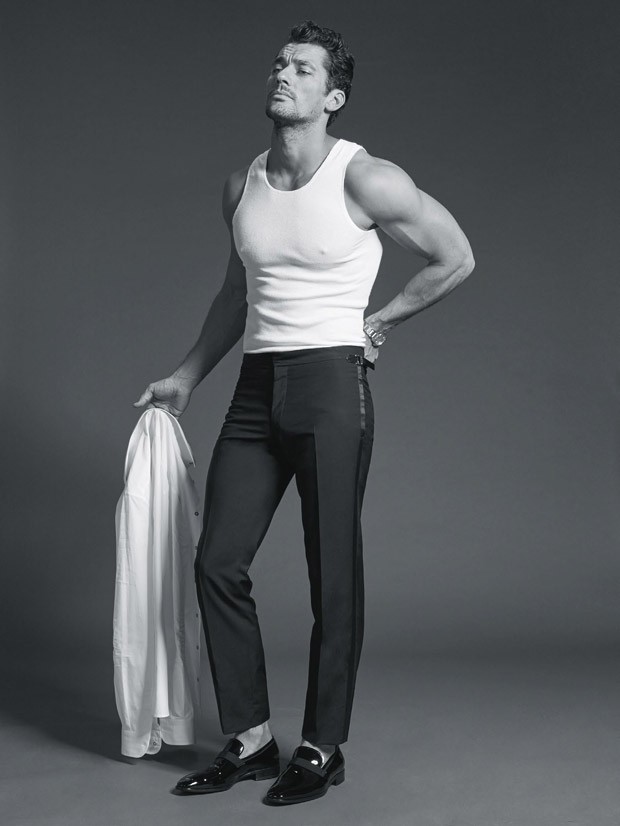Is there more to male modeling than being really, really ridiculously good looking? Last month I flew to Miami to interview 39-year-old David Gandy, one of the most famous and highest paid male models in the world, to find out. Like his female supermodel counterparts, Gandy’s success runs the gamut from international runways and campaigns for iconic fashion houses to photoshoots with legendary photographers and a massive billboard in Times Square. Since 2006, he has been loyal to Dolce & Gabbana specifically their Light Blue Pour Homme fragrances, which he’s been the face of for nearly a decade. In honor of the brand’s latest aquatic scent, Light Blue Swimming in Lipari (think crisp, masculine notes like sea salt, mandarin, dry woods, and musk), I met up with the British model seaside to discuss male grooming, man buns, dad bods, fashion faux pas, and what makes male models tick. 

What are the biggest misconceptions about male models?
David Gandy: Oh, where do I start? I could spend about half an hour on this subject. I’ve even written for Vogue and GQ and the Daily Telegraph in London and in any article I’ve written and it’s trying to change that perception. The only thing people have seen is Zoolander, so people have that perception that we’re not very intelligent. That’s one reason I diversified into writing and my own brands — I’ve tried to make fashion and modeling a little more tangible. It gives insight into an industry that’s a little bit mysterious.
There are so many female models that girls can identify and know by name, but there are very few well-known male models. Why do you think that is? And how did you set yourself apart?
I think we were always told, “This is your limitations, you’re never going to earn as much as the women,” and I looked at that and I thought, “Well that’s wrong.” We’re in the same campaigns, we’re in the same coverage, and no one was really building a brand. There are so many models out there that you really have to differentiate yourself from them all, and of course we’re not just against male models — we are up against the biggest male stars in the world. So you have to bring something extra to that. I saw it as a business, and I read up on how Cindy Crawford and Christy Turlington and all these guys who are still my influences, and said, “Where can we take that for male modeling?”

How did you get started?
David: Oh, the early days. I was at university and a housemate of mine, without my knowing, sent in some pictures to a television program. It wasn’t like an “X-Factor” or anything — it was a very small competition on morning television. So, I went on and won, and carried on from there. I didn’t start out doing much at all, because I was the freak in the modeling industry. Everything was very androgynous — the tall, skinny Dior guys were in at the time and I was quite a big guy. But fashion goes around in circles, so I knew the masculine guy would come back in style. I started working with Dolce. In 2005 I got the apparel line, and then Light Blue in 2006. Eight years later here we are.
As your career has grown, do you ever have moments that still blow you away like seeing your face on a billboard in Times Square?
Which I never got to see.

Oh, no way!
Yeah I was in London, but I had friends sending me pictures. Times Square would’ve been very special to see. There are some people who go find themselves [on a billboard] and take a selfie, but I’ve never really been that sort of person. I’m very critical and I sort of see it as another person, it’s my job and my persona. But I do pinch myself all the time about the people I get to meet and the locations, and everything really.
In the early days did you ever have to do anything that you weren’t totally comfortable with or anything embarrassing?
Oh, of course, and the thing is it never goes away! With digital and the internet, you can shoot something 10 years ago that will appear once you get famous, so you have to be very careful. I was never shy about walking off a shoot or saying I didn’t want to do something. A lot of people take it very, very seriously, but we’re not saving lives here. We’re not brain surgeons. It’s fashion and we should all just feel very privileged at the end of the day that we get to be here and live the life we do.


No comments:
Post a Comment